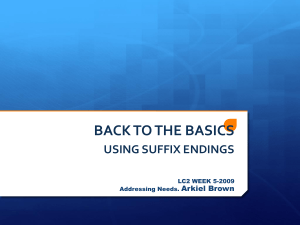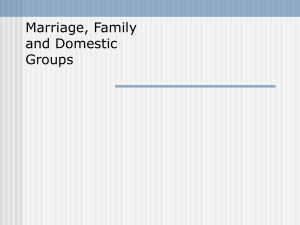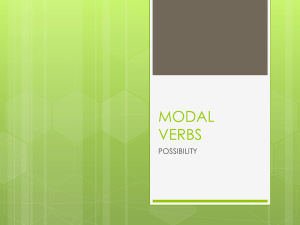Yahshua`s Engagement to His Bride
advertisement
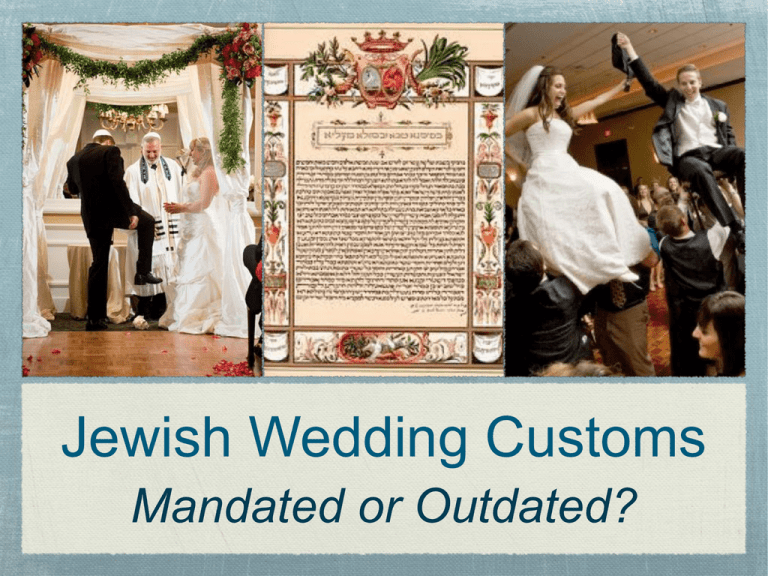
Jewish Wedding Customs Mandated or Outdated? 4 Stages of Ancient Jewish Marriage Choosing of the Bride Engagement (Erusin) Wedding Ceremony Wedding Celebrations Yahshua referred to Himself as the Bridegroom John 3:29 Matthew 9:15 Mark 2:19-20 Luke 5:34-35 Matthew 25:1-6 Choosing The Bride Parents were responsible for choosing appropriate spouses for their children, and the young man and woman were expected to accept their parents’ arrangements Often the man would go to his father and tell Him who He wanted to marry (Judges 14:2-3) The father would then begin to arrange the marriage either himself or through another male representative (Genesis 24) Even in the time of the New Testament, this custom was still being followed by the early believers (1 Cor 7:36) Yahweh & Yahshua chose the bride John 15:16,19 2 Thessalonians 2:13 Deuteronomy 10:15 Deuteronomy 7:6-7 1 Peter 1:2 Romans 11:2 Colossians 3:12 Yahshua specifically chose the Jewish nation and all those that would bind themselves to His laws and commands to be His bride. Engagement The process of betrothal began when the prospective groom and his father or a close male relative came to the bride’s house to meet with her father and determine the conditions of the marriage contract. Once the terms of the marriage were agreed upon, the groom could formally “propose” to his prospective bride. He would present her with a ketubah, a beautifully decorated formal document that specified the marriage terms and stated his intent to consecrate himself to his bride-to-be The groom then offered her a gift of value (mohar), a possession symbolic of his esteem for her and his willingness to sacrifice in her behalf. Often this gift was gold, coins and/or jewellery (Genesis 24:53) (Luke 15:8-9) The groom then poured a cup of wine for the prospective bride. Because Jewish law stated that a woman could not be forced to marry a man distasteful to her, the bride was ultimately allowed to choose whether to accept or reject the groom’s proposal. If she drank the cup he offered, they were betrothed. Engagement The groom would formally accept his bride with another ritual statement, often “You are set apart (or consecrated) for me according to the law of Moses and Israel.” Interestingly, the same word for “set apart” was also used to describe a dedicated temple; the bride was considered a temple now set apart for her husband. From this point on, the bride would wear a veil over her hair in public to indicate her status as a betrothed or married woman. Some believe that this is why Shaul told women to cover their heads. Once the bride drank from the wine cup that the groom offered her, she was bound to the man and only a divorce could separate them. If she was with another man, it was considered adultery even though she was still a virgin The groom would then go back to His father’s house and there He would add on rooms as a place for he and his bride to live after they were married. Yahshua’s Engagement to His Bride The Father (Yahweh) chose Israel to be a bride for His son. Passover was when Yahweh called the bride out of slavery and set her apart for His Son. The Ketubah was given outlining the responsibilities that we have towards our husband and what our husband will do for us. It was called the Torah! (Exodus 34:28) Israel repeatedly played the spiritual harlot and did not obey the terms of the Ketubah (Torah). (Ezekiel 16:18,28, Isaiah 23:16, Hosea 4:15, Ezekiel 23:19, Jeremiah 2:20) Yahshua’s Engagement to His Bride After the Ketubah was given and accepted, the groom could propose to His bride. Yahshua came to do just that. The Last Supper - Matthew 26:26 - 28 ‘Communion’ is not a monthly or weekly ritual, it is annual remembrance of the betrothal we entered into with Yahshua...it is Passover! If, after we enter into this covenant with Yahshua, we commit spiritual adultery by trying to be like the world, we are in serious trouble. The penalty would be spiritual divorce or death. (Hebrews 10:26, Hosea 4:15, Leviticus 20:10) Yahshua’s Engagement to His Bride By His death, Yahshua fulfilled the requirement that a bride could be released from her marriage vow when her betrothed dies. By His resurrection, He made a way for us to be married once again to Him without breaking the law. Deut 24:1-4 The gift that Yahshua gave to His bride was the Ruach Ha’Quodesh (Luke 24:49, Acts 1:4, Ephesians 4:8, 1 Cor 1:7, ) Yahshua promised that He would go and prepare a place for His bride (John 14:2-3) Wedding Ceremony The bride had no idea of the exact day and hour that the groom would come for her, so she always waited in expectation. The wedding day has, for both the bride and groom, all the sanctity and solemnity of Yom Kippur. Both will fast until after the chuppah ceremony through which time they will seek Yahweh’s forgiveness for any past wrongdoings. Since on the day of one's wedding Yahweh forgives the bride and groom of all their previous transgressions, it is seen as a private Yom Kippur for the couple. www.jewishhistory.com The bride would also mikvah on the day of her wedding as a symbol of purification (Rev 19:7) All converts to Judaism were required to mikvah as well. www.myjewishlearning.com When the groom was coming, a few would run ahead and shout “the bridegroom is coming” and the bride had a very short time to be ready to meet him Wedding Ceremony The Bride and groom would stand underneath a covered Chuppah. In ancient times a tallit (prayer shawl) would be spread over the heads of the couple. This symbolized that Yahweh Himself would be their covering. (Psalm 91:4) The bride and groom would again drink wine to symbolize their dedication for each other (Matthew 26:29) The bride would wear a full veil to symbolize modesty and a focus on inward rather than outward beauty (1 Peter 3:3) Both the bride and the bridegroom would wear white. The bride wore a white dress and veil (symbolizing purity) and the groom would wear a white tallit draped over his shoulders. The Wedding of Yahshua We, as the bride of Yahshua, have no idea of the day or the hour in which our bridegroom will come for us (Matthew 24:35-36) Fasting precedes the wedding (Isaiah 58:5, Joel 2:15) We must ‘mikvah’ as part of our being made ready for our groom (Matt 28:19, John 4:1, Acts 2:38, Acts 13:24) Yahshua will come with a shout (1 Thess. 4:16) The ‘Chuppah’ will beYahweh Himself who will be over us (Isaiah 62:5, Zephaniah 3:17, Deut 30:9) We will drink wine with our bridegroom in the kingdom of heaven (Matthew 26:29) Our veil will be taken off when we meet our bridegroom (Exodus 34:34, 2 Cor 3:14) We and our bridegroom will be in white (Rev. 1:14, Rev. 3:4-5 &18, Rev. 4:4, Rev 7:9, Rev. 19:14) After the Wedding After the marriage ceremony, the bride and groom would consummate their marriage and the groom would then present her as his bride to the wedding guests. In ancient times, the couple would be in the wedding chamber for 7 days before coming out. The feasting and celebration would begin when they came out! Yahshua is going to present His bride to the world (Ephesians 5:27) There will be a huge wedding feast! (Rev. 19:9) How the Feasts of Yahweh factor into the Marriage of Yahshuah The Feast of Trumpets (Rosh Hashanah) is when some scholars believe that Yahshua will return. Since it falls on the 1st day of the 7th month and the months are determined by the sighting of a new moon, no man knows the day or the hour it will begin. In Jewish thought, Rosh Hashanah is the most important judgment day, on which all the inhabitants of the world pass for judgment before the Creator. (Revelation 20:12) The Feast of Tents (like the Chuppah!) (Sukkot) takes place on the 15th day of the 7th month. Seven days after the Feast of Trumpets ends. The feast lasts for 7 days, the time that the Bride & Groom spend in the wedding chamber in ancient times. This is a time of great joy and celebration and no hard labour is done. (Hebrews 4:3) Modern Non-Jewish Traditions Wedding Cakes - Began as a tradition with the Romans. Used to be a loaf of bread broken over the bride’s head as a symbol of male dominance Throwing Rice - Pagans held the simple belief that the fertility of the seeds would be transferred to the couple. The symbolism of throwing rice holds same symbolic meaning. Beginning in the Middle Ages, rice became a symbol of fruitfulness amongst many early peoples. The tradition of throwing of rice may also have been a way to ward off evil spirits that hung around near the bride and groom. It may also have its origins in the "food tossing ritual," discussed elsewhere in this article. Bouquet Toss - Centuries ago, brides traditionally carried with them aromatic bunches of garlic, fruit blossoms, herbs, and grains to drive away evil spirits and symbolize prosperity. Over the years, the herbs and grains were replaced by flowers, a sign of happiness that represented fertility and everlasting love. Honeymoon - The term 'honeymoon' first originated in Babylon, about 4,000 years ago. Honeymoon came into use for the month after a wedding, when the bride's father would give the groom all the mead he wanted. Mead is actually a honey beer, and being so, the Babylon's calendar was a lunar calendar, which is based off the moon. They then started to call that month, the 'honey month', which we now have adapted to be honeymoon. Modern Non-Jewish Traditions Wedding Rings - It was the ancient Egyptian who established the custom of placing a ring on the finger of his wife, as a sign that he had confidence in her ability to care for his house. The Greek and Roman bridegroom often gave a ring to the bride's father-a practice that was probably a survival of primitive bride purchase. In the second century B. C., the Roman bride was presented with a gold ring. It was not until about 860 that the Christians used the ring in marriage ceremonies, and then it was not the plain circlet that we now use, but a highly decorated device, engraved with symbolical figures of doves, lyres and even of two linked hands. Such a "Heathenish" gadget was not given a hearty reception by the Church, and for a long time its use was discouraged, though never completely abandoned. Carrying Over the Threshold - Superstitious Western Europeans believed that a bride who tripped over the threshold of her new home would irrevocably bring bad luck to her home and marriage. Since the husband appears to have been immune from such happenstance, the groom carrying the bride into the home proved a good way to avoid such a mishap altogether [source:World Wedding Traditions]. This fear of tripping appears to have its roots in ancient Roman culture, which held a similar belief. Points to ponder.... If Yahshua is following the ancient Jewish customs in His marriage to His bride, should not we as believers practice the same instead of customs that originated from paganism? Communion is a Roman Catholic tradition but Passover is mandated...we are to remember the covenant Yahshua made! Adultery with the world is a serious offense! Beware of becoming like the world in practice or looks. There is NOTHING in the Jewish marriage model that even hints at a secret rapture We should be following the Ketubah (Torah) and be mikvah’d in preparation for our marriage to Yahshua We need to watch for the arrival of our bridegroom

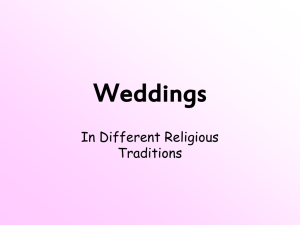
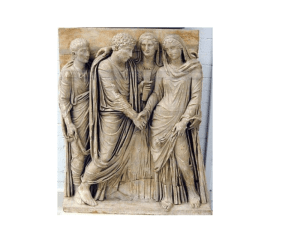

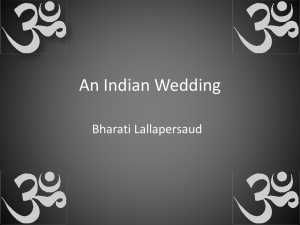
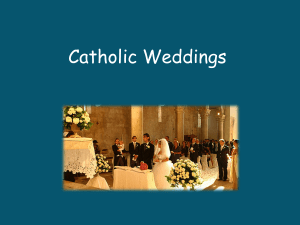
![What do they mean? [KOLA NUT]](http://s2.studylib.net/store/data/005273036_1-7e5e564e9d9071770b510ba51156f003-300x300.png)
